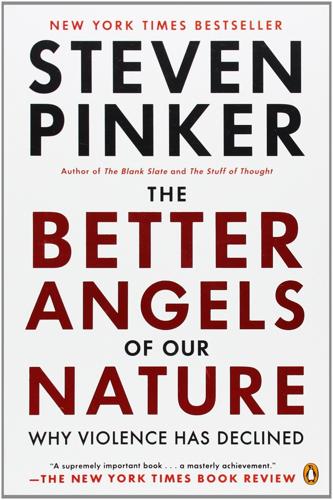Hobbesian trap
description: a situation in which two parties cannot trust each other and therefore end up in a state of mutual harm, named after the philosopher Thomas Hobbes.
5 results

The Blank Slate: The Modern Denial of Human Nature
by
Steven Pinker
Published 1 Jan 2002
Even more tragically, your neighbors have every reason to be cranking through the same deduction, and if they are, it makes your fears all the more compelling, which makes a preemptive strike all the more tempting, which makes a preemptive strike by them all the more tempting, and so on. This “Hobbesian trap,” as it is now called, is a ubiquitous cause of violent conflict.63 The political scientist Thomas Schelling offered the analogy of an armed homeowner who surprises an armed burglar. Each might be tempted to shoot first to avoid being shot, even if neither wanted to kill the other. A Hobbesian trap pitting one man against another is a recurring theme in fiction, such as the desperado in Hollywood westerns, spy-versus-spy plots in cold-war thrillers, and the lyrics to Bob Marley’s “I Shot the Sheriff.” But because we are a social species, Hobbesian traps more commonly pit groups against groups.
…
In the past century, World War I, the Six-Day Arab-Israeli War, and the Yugoslavian wars in the 1990s arose in part from Hobbesian traps.68 The political scientist John Vasquez has made the point quantitatively. Using a database of hundreds of conflicts from the past two centuries, he concludes that the ingredients of a Hobbesian trap—concern with security, entangling alliances, and arms races—can statistically predict the escalation of friction into war.69 The most conscious playing-out of the logic of Hobbesian traps took place among nuclear strategists during the cold war, when the fate of the world literally hinged on it.
…
Our species’ vaunted ability to make tools is one of the reasons we are so good at killing one another. The vicious circle of a Hobbesian trap can help us understand why the escalation from friction to war (and occasionally, the de-escalation to detente) can happen so suddenly. Mathematicians and computer simulators have devised models in which several players acquire arms or form alliances in response to what the other players are doing. The models often display chaotic behavior, in which small differences in the values of the parameters can have large and unpredictable consequences.66 As we can infer from Hobbes’s allusion to the Peloponnesian War, Hobbesian traps among groups are far from hypothetical.

The Better Angels of Our Nature: Why Violence Has Declined
by
Steven Pinker
Published 24 Sep 2012
In fact, even if he knew that you started out with no aggressive designs on him, he might legitimately worry that you are tempted to neutralize him out of fear that he will neutralize you first, which gives you an incentive to neutralize him before that, ad infinitum. The political scientist Thomas Schelling offers the analogy of an armed homeowner who surprises an armed burglar, each being tempted to shoot the other to avoid being shot first. This paradox is sometimes called the Hobbesian trap or, in the arena of international relations, the security dilemma.8 How can intelligent agents extricate themselves from a Hobbesian trap? The most obvious way is through a policy of deterrence: Don’t strike first; be strong enough to survive a first strike; and retaliate against any aggressor in kind. A credible deterrence policy can remove a competitor’s incentive to invade for gain, since the cost imposed on him by retaliation would cancel out the anticipated spoils.
…
Or they may raid to claim women who had been promised to them in marriage but were not delivered at the agreed-upon time. And sometimes young men attack for trophies, coups, and other signs of aggressive prowess, especially in societies where they are a prerequisite to attaining adult status. People in nonstate societies also invade for safety. The security dilemma or Hobbesian trap is very much on their minds, and they may form an alliance with nearby villages if they fear they are too small, or launch a preemptive strike if they fear that an enemy alliance is getting too big. One Yanomamö man in Amazonia told an anthropologist, “We are tired of fighting. We don’t want to kill anymore.
…
In other words, if one state has reason to believe that a neighboring one organizes its political affairs in the same way that it does because both have stumbled upon the same solution to the problem of government, then neither has to worry about the other one attacking, neither will be tempted to attack the other in preemptive self-defense, and so on, freeing everyone from the Hobbesian trap. Today, for example, the Swedes don’t stay up at night worrying that their neighbors are hatching plans for Norway Über Alles, or vice versa. The third condition for perpetual peace is “universal hospitality” or “world citizenship.” People from one country should be free to live in safety in others, as long as they don’t bring an army in with them.

Enlightenment Now: The Case for Reason, Science, Humanism, and Progress
by
Steven Pinker
Published 13 Feb 2018
Their governments can afford to provide services like health care, education, and policing and thus outcompete rebels for the allegiance of their citizens, and they can regain control of the frontier regions that warlords, mafias, and guerrillas (often the same people) stake out.27 And since many wars are ignited by the mutual fear that unless a country attacks preemptively it will be annihilated by a preemptive attack (the game-theoretic scenario called a security dilemma or Hobbesian trap), the alighting of peace in a neighborhood, whatever its first cause, can be self-reinforcing. (Conversely, war can be contagious.)28 That helps explain the shrinking geography of war, with most regions of the globe at peace. * * * Together with ideas and policies that reduce the incidence of war, there has been a change in values.
…
If even a few potential predators lurk in the region or could show up on short notice, people must adopt an aggressive posture to deter them. This deterrent is credible if only they advertise their resolve by retaliating against any affront and avenging any depredation, regardless of the cost. This “Hobbesian trap,” as it is sometimes called, can easily set off cycles of feuding and vendetta: you have to be at least as violent as your adversaries lest you become their doormat. The largest category of homicide, and the one that varies the most across times and places, consists of confrontations between loosely acquainted young men over turf, reputation, or revenge.
…
It’s not that deterrence itself is irrelevant: World War II showed that conventional tanks, artillery, and bombers were already massively destructive, and no nation was eager for an encore.104 Far from easing the world into a stable equilibrium (the so-called balance of terror), nuclear weapons can poise it on a knife’s edge. In a crisis, nuclear weapon states are like an armed homeowner confronting an armed burglar, each tempted to shoot first to avoid being shot.105 In theory this security dilemma or Hobbesian trap can be defused if each side has a second-strike capability, such as missiles in submarines or airborne bombers that can elude a first strike and exact devastating revenge—the condition of Mutual Assured Destruction (MAD). But some debates in nuclear metaphysics raise doubts about whether a second strike can be guaranteed in every conceivable scenario, and whether a nation that depended on it might still be vulnerable to nuclear blackmail.

The Rationalist's Guide to the Galaxy: Superintelligent AI and the Geeks Who Are Trying to Save Humanity's Future
by
Tom Chivers
Published 12 Jun 2019
‘It was the mutual fears of these two defensive alliances, and the general insecurity created by the erratic character of the imperialistic utterances of William II, that inspired the diplomatic manoeuvres during the two decades before the First World War,’4 writes the historian Hans Morgenthau. This is a classic game-theory problem, known as the stag-hunt game, and related to the famous prisoners’ dilemma. It’s also known as the Hobbesian trap, after Thomas Hobbes, who said that greed, glory and fear are the three principal causes of war.5 You can model it with simple numbers. You’ve got two players, each with two options: either behave aggressively or behave peacefully. If you both behave peacefully, you have peace. There is no cost to peace, so we give that a payoff of 0.

The Dawn of Everything: A New History of Humanity
by
David Graeber
and
David Wengrow
Published 18 Oct 2021
Some of these accusations appear baseless, but the rhetoric of Chagnon’s defenders grew so heated that (as another celebrated anthropologist, Clifford Geertz, put it) not only was he held up as the epitome of rigorous, scientific anthropology, but all who questioned him or his social Darwinism were excoriated as ‘Marxists’, ‘liars’, ‘cultural anthropologists from the academic left’, ‘ayatollahs’ and ‘politically correct bleeding hearts’. To this day, there is no easier way to get anthropologists to begin denouncing each other as extremists than to mention the name of Napoleon Chagnon.22 The important point here is that, as a ‘non-state’ people, the Yanomami are supposed to exemplify what Pinker calls the ‘Hobbesian trap’, whereby individuals in tribal societies find themselves caught in repetitive cycles of raiding and warfare, living fraught and precarious lives, always just a few steps away from violent death on the tip of a sharp weapon or at the end of a vengeful club. That, Pinker tells us, is the kind of dismal fate ordained for us by evolution.